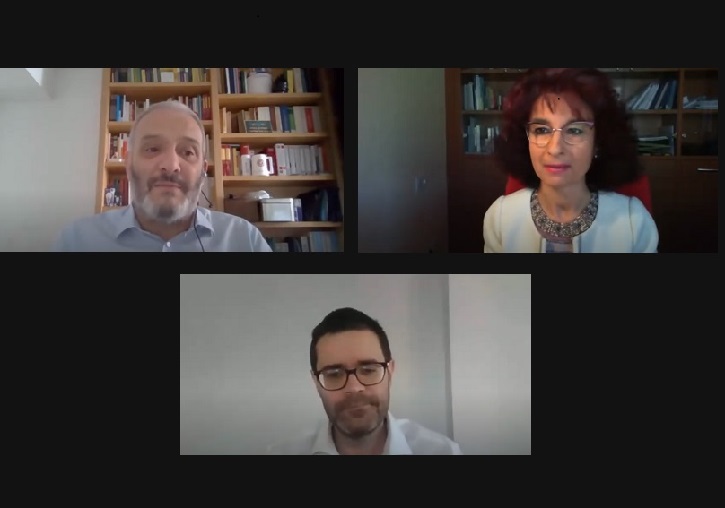Specialists from three universities analyse the legal regulation and conditions of teleworking
- Scientific Culture and Innovation Unit
- June 2nd, 2020

Three specialists in Labour and Social Security Law from the universities of València, Seville and Santiago de Compostela have analysed whether telework is a right or an obligation, how to control compliance with labour obligations, how to compensate the use of own means or what role social agents must have in their negotiation. Currently in Spain approximately 10 million people telework as a result of the COVID-19 pandemic.
“There is a need for clearer criteria on the part of the authorities so that there are no conflicts and uncertainty in the process of de-escalation and progressive incorporation into on-site work”, said Adrián Todolí, professor in the Department of Labour and Social Security Law at the University of Valencia. In addition, in the virtual webinar ‘PostCOVID teleworking: Opportunity or risk?’, Organised by the Chair of Collaborative Economy and Digital Transformation of the University of Valencia and sponsored by the Las Naves Foundation of the Valencia City Council, the expert highlighted: “More than controlling how a specific task is performed, it is more convenient to focus attention on the results of teleworking”.
Regarding whether it is a right or an obligation, traditionally in Spain telework has been seen as a mechanism for reconciling family and work life, a fact that until three months ago was only used by few people, according to Miguel Rodríguez-Piñero , Professor of Labour Law and Social Security at the University of Seville. For health reasons, article 5 of Royal Decree-Law 8/2020 considers it as an obligation, whenever possible.
Currently, this labour practice is regulated in article 13 of the Workers Statute and in the European Framework Agreement for Teleworking, as well as in regulations of some Communities. According to Lourdes Mella, professor at the Department of Labour and Social Security Law at the University of Santiago de Compostela, the general rule is to recognise teleworking for family reconciliation and in very specific cases as a right with very strict requirements.
Regarding the equipment to carry out teleworking, its reduction in cost has led to BYOD (Bring your own device), by which the company at most uses programs or apps that the worker installs on their own devices. In last Thursday’s webinar moderated by La Vanguardia journalist Alicia Rodríguez de Paz, Adrián Todolí, director of the Chair for Collaborative Economy and Digital Transformation, pointed out that cost savings for the teleworking company (as in transport bonuses) do not have to imply that the worker assumes these costs. Rodríguez-Piñero, Mella and Todolí agreed that the form of compensation is lump sum compensation, consisting of paying a small percentage of the total expenses caused by teleworking (for example, the price of the computer or that of Wi-Fi, even that of renting the home where you telework), an experience that is already applied in France, Belgium or Switzerland.
The speakers highlighted the psychosocial risks derived from techno-stress or work intensity, as well as the risks to physical health derived from sedentary lifestyle or the inadequacy of the work tools themselves. One of the issues related to health risks is digital disconnection. Adrián Todolí pointed out that this right is already regulated, but not put into practice, since companies have generally not approved protocols to give effect to the right not to work, not to answer calls, emails or notifications outside of working hours. The verification of these measures, as Mella warned, is complicated, since the access of the labour inspection to the home is impractical since it is inviolable.
Work-related accident at home
Lourdes Mella stressed that there is no specific regulation on accidents in the context of teleworking, although if you are in the workplace and at work hours, there must be a presumption of an accident at work. Another situation is if the worker has time freedom, since the time record or proof of working would come into play.
Regarding the control of teleworking, it involves greater possibilities through electronic means. These, although invasive, in classroom work would be disproportionate. Todolí aims to monitor the screen during work time, subsequently see the worker’s history, or control his or her email account, among others. However, it opens two possibilities depending on who the devices belong to. If this is exclusive to the employee, it would not be possible, as a general rule, to install devices or programs such as those mentioned.
Hours and days of teleworking
Another of the coinciding points among the speakers is to understand that the solution to the teleworking day is to try not to do it daily, but to adopt the Dutch model and choose two or three days of teleworking, as Todolí pointed out. Currently, teleworking with fully effective working times could not be required, given the difficulties in reconciling work and family life.
Collective negotiation
Until now, collective agreements have not effectively regulated teleworking, which has made it difficult to adapt to the need to work during the COVID-19 health crisis. According to Adrián Todolí, “the legal and regulatory regulation of teleworking must lay the foundations of the matter using clear and precise concepts. It is collective bargaining that must adapt, based on that legal precision, the practical and concrete terms”.
The three speakers also agreed on the need, already in a postCOVID scenario, for social partners to face the challenge of regulation through collective agreements. In this work, it is essential to trust the potential of teleworking and to see company agreements already in operation, such as Repsol or BBVA, for example, in addition to using public sector regulations as a reference for their previous experience.
File in: Investigació a la UV , Internacionalització recerca , Grups de recerca , Facultat de Dret , Col·laboració amb empresa , Dret del Treball i de la Seguretat Social



















